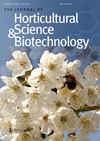柚子(Citrus junos Sieb)遗传多样性分析。Ex Tanaka),使用通过RNA-seq和全基因组重测序分析鉴定的单核苷酸多态性
IF 2.1
4区 农林科学
Q2 HORTICULTURE
Journal of Horticultural Science & Biotechnology
Pub Date : 2023-10-10
DOI:10.1080/14620316.2023.2265360
引用次数: 0
摘要
柚子(Citrus junos Sieb.)在亚洲广泛种植。但是,目前还没有一个品种鉴定系统。采用RNA-seq分析方法鉴定了包括无籽品种在内的5个柚子样品的变异。然而,只发现了四个变体,这表明无籽性状可能源于芽突变。为了确定更多的变异,进行了全基因组重测序。总共筛选了140个可靠的变异。基于这些变体,开发了30个高分辨率熔化(HRM)标记。利用HRM标记对265份柚子样品进行基因分型,将其分为18种类型。3个鱼祖样样品(B-37-1、B-UK2和B-MD6-8)表现出不同的果实形态和异型HRM峰模式,被认为是源自种间杂交。为了鉴定这些鱼祖样样品的亲本种,我们获得了一个高变叶绿体基因组区域和一个负责珠心胚胎的核CitRWP基因的核苷酸序列。叶绿体基因组序列分析表明,B-37-1和B-MD6-8的母本为柚子,而B-UK2序列与甜橙相同。此外,CitRWP序列表明,B-37-1、B-UK2和B-MD6-8的父本分别为柑桔、柚子和柚。作者感谢Ji-hwa Heo, Jeong-An Yoo和Su-jeong Kim的技术支持。本研究由“农业科技发展合作研究计划”(项目编号:No. 8111111)资助。PJ016161),由韩国农村振兴厅资助,由韩国教育部和韩国国家研究基金会资助的BK21 FOUR基金。披露声明作者未报告潜在的利益冲突。数据可用性声明本研究获得的转录组和全基因组重测序数据可在NCBI SRA数据库中获取。补充资料本文的补充资料可在https://doi.org/10.1080/14620316.2023.2265360.Additional information网站上获取。本文章由计算机程序翻译,如有差异,请以英文原文为准。
Analysis of genetic diversity of yuzu ( Citrus junos Sieb. Ex Tanaka) using single nucleotide polymorphisms identified through RNA-seq and whole-genome resequencing analyses
ABSTRACTYuzu (Citrus junos Sieb. Ex Tanaka) is widely cultivated in Asia. However, a system for variety identification has not been developed yet. RNA-seq analysis was performed to identify variants among five yuzu samples including a seedless variety. However, only four variants were found, suggesting that the seedless trait might originate from bud mutations. To identify more variants, whole-genome resequencing was performed. A total of 140 reliable variants were screened. Based on these variants, 30 high-resolution melting (HRM) markers were developed. After genotyping 265 yuzu samples using the HRM markers, the yuzu samples were classified into 18 types. Three yuzu-like samples (B-37-1, B-UK2, and B-MD6-8) showing different fruit morphologies and off-type HRM peak patterns were assumed to originate from interspecific hybridisation. To identify the parent species of these yuzu-like samples, nucleotide sequences of a hypervariable chloroplast genomic region and a nuclear CitRWP gene responsible for nucellar embryony were obtained. Chloroplast genome sequence analysis indicated that the maternal parents of B-37-1 and B-MD6-8 were yuzu, whereas the B-UK2 sequence was identical to that of sweet orange. Moreover, the CitRWP sequences indicated that the male parents of B-37-1, B-UK2, and B-MD6-8 were mandarin, yuzu, and pummelo, respectively.KEYWORDS: YuzuCitrus junosvariety identificationmolecular markerhigh-resolution meltingnucellar embryony AcknowledgementsThe authors thank Ji-hwa Heo, Jeong-An Yoo, and Su-jeong Kim for their dedicated technical assistance. This study was supported by the “Cooperative Research Program for Agriculture Science and Technology Development (Project No. PJ016161)” funded by the Rural Development Administration, Republic of Korea, and the BK21 FOUR grant funded by the Ministry of Education of Korea and National Research Foundation of Korea.Disclosure statementNo potential conflict of interest was reported by the author(s).Data availability statementTranscriptome and whole genome resequencing data obtained in this study are accessible at NCBI SRA database.Supplementary materialSupplemental data for this article can be accessed online at https://doi.org/10.1080/14620316.2023.2265360.Additional informationFundingThe work was supported by the Rural Development Administration [PJ016161].
求助全文
通过发布文献求助,成功后即可免费获取论文全文。
去求助
来源期刊
CiteScore
3.90
自引率
5.30%
发文量
67
审稿时长
3 months
期刊介绍:
The Journal of Horticultural Science and Biotechnology is an international, peer-reviewed journal, which publishes original research contributions into the production, improvement and utilisation of horticultural crops. It aims to provide scientific knowledge of interest to those engaged in scientific research and the practice of horticulture. The scope of the journal includes studies on fruit and other perennial crops, vegetables and ornamentals grown in temperate or tropical regions and their use in commercial, amenity or urban horticulture. Papers, including reviews, that give new insights into plant and crop growth, yield, quality and response to the environment, are welcome, including those arising from technological innovation and developments in crop genome sequencing and other biotechnological advances.

 求助内容:
求助内容: 应助结果提醒方式:
应助结果提醒方式:


